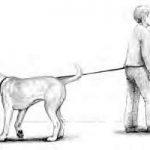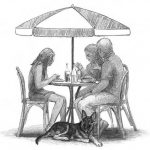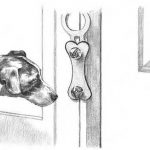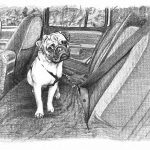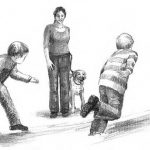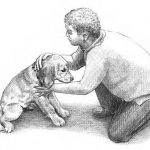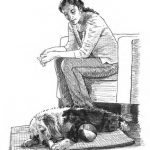Raising a Puppy: Making Heads and Tails of It
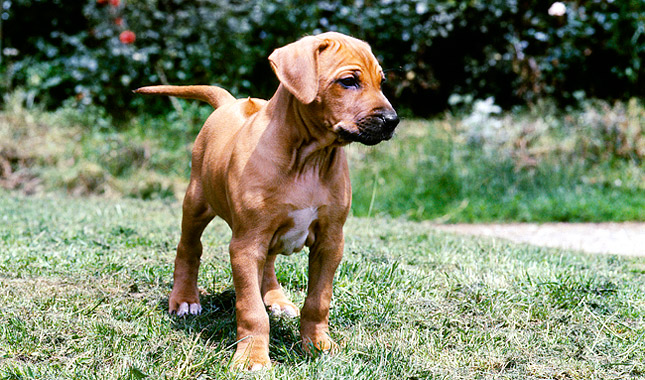
In This Chapter
- Understanding the differences between puppies
- Helping your pup settle in with the family
- Training with your pup’s age in mind
- Dealing with the infamous puppy behavior
- Taking care of your puppy
If you parallel your puppy’s first year with the first 18 years of a child’s life, you’ll have a good sense of what’s in front of you for the next 360 days. Civilizing a puppy is a lot like civilizing a child — fortunately, though, it only takes a year. And, your puppy won’t ever wreck the car, max out your credit cards, or leave for college!
A Puppy Is a Puppy — Right?
Remember
In addition to breed, a puppy’s personality and temperament should influence selection. Like kids, each puppy has a personality that’s markedly defined by the time he’s 8 weeks old. However, unlike kids, you can pick your puppy’s personality.
A word on breeds
Your dog’s ingrained need for a jobA puppy’s instinctual skills, with a few exceptions, are no longer necessary to human survival. But, please don’t let your puppy in on this secret. His skills are his life’s talent and employing them will give his life a sense of purpose. No sheep to herd? The neighborhood kids will do. No snow in Savannah? Pulling a skateboarder will satisfy a Siberian Husky. No ducks to retrieve? A tennis ball will do just fine. Dogs love to work, and they can’t quell their passions just because you have a late meeting. |
Just For Fun
Over time more than 420 known breeds have been developed worldwide. Each of these breeds has specific characteristics that allow the dogs to withstand the environment of the lands of their original decent. Each breed has a defined look, temperament, and interest that continues to get passed down from generation to generation.
Deciding what breed (if any) is right for you
Remember
After you’ve narrowed your breed choice, you’re ready to begin the adventure of finding your puppy. First impressions count — make sure your puppy’s first home, whether it’s a breeder, shelter, store, or private home, is a safe, positive, and relaxed environment where you feel comfortable asking any pertinent questions and voicing your concerns. Many good breeders will question you because they want to find good homes for the puppies they love like infants.
Helping Your Puppy Jump into the Family Groove
Remember
Regardless of your mood, this initial trip can be scary and overwhelming for your puppy, who may be separating from his first family for the very first time. Plan ahead by organizing both the trip home and your arrival. Make your puppy-supply purchases, which are listed in Chapter Home Sweet Home, well in advance. Also, before your pup comes home, be sure to set up his first room, and explain your itinerary to family and friends. Having a plan puts your mind at ease, which will help your puppy get through this transition stage. Your puppy will bond to you and his new life in no time.
Understanding your puppy’s point of view
Positively overdoing socialization
Tip
If you want a well-rounded, gently mannered dog, there’s one secret you must know: Overdo socialization in puppyhood! Overdo socialization even more so than training. Expose you puppy to everything — objects, surfaces, sounds (inside and out), places, and people of all ages, races, sexes, and sizes. Expose your pup to other animals and pets too. Even changes in weather patterns must be handled mindfully. If your puppy is startled or concerned, a soothing reaction from you may actually be misinterpreted as mutual fear. To teach him how to manage himself, reassure your puppy with your confidence and direction. Knowing how to calm him when he’s stressed can make the difference between a pet who rolls with the changes and one who emotionally locks up or reacts defensively. (Chapter Life from His Paws: Understanding Your Puppy’s View of the World gives the lowdown on socializing your pup.)
Warning!
Until your puppy is fully inoculated do not take him out in public to socialize. Various life-threatening viruses are airborne and can be picked up by simply sniffing about. In addition, I’ve heard reports of young, playful puppies who have not had their rabies inoculation forcibly euthanized after nipping a stranger. Take precaution.
Raising a pup with children and within a neighborhood
Enduring life changes
Remember
Puppyhood is a time for many changes, both physical and emotional. During their first months, puppies go through different cycles: One day they’ll love your neighbor and the next day they’ll hide. One day they’ll be bold and assured when entering your car and the next they’ll put on the brakes and refuse to follow you. Don’t worry, this behavior is nothing out of the ordinary — puppies have a lot of nuances to contend with. These periods are scary for any puppy, but they give you the perfect opportunity to strengthen your connection to him by managing his anxiety with concern and confidence. You become the Great Oz as you increase his trust and reliability in your judgment.
Tackling Training through Your Puppy’s Growth Phases
Knowing what you’re in for
– Infancy: Infancy is a magical time for your puppy! Delightfully self-centered and curious, he’s experiencing his world — and all the people in it — for the first time. This phase isn’t the time to interject your opinion too strongly. Let him explore while encouraging positive behaviors and structuring your schedule and affections around his needs. Shouting “No” repeatedly is a turnoff: Like an infant, your puppy doesn’t have the capacity to comprehend right from wrong.
– Terrible Twos: Before the terrible twos start, you may be convinced that you’ve adopted an angel. During his infancy, your puppy will follow you everywhere, sleep for hours, and run to you when you call. Then it will happen almost overnight: Your puppy will fall from grace. Suddenly you’ll be under slipper assault, the nipping will be relentless, and racing away from you will be your pup’s new game. During the terrible twos phase, you may dream about the day you adopted him and may fantasize about leaving him on your neighbor’s doorstep. If it’s any consolation, all his mischief is a wonderful sign of normal development. Your puppy is growing up. Knowing how to handle his behavior and how to control your own frustration is critical in getting through this trying time. Help is on its way.
– Budding Adolescent: Okay, by now you’re getting a good glimpse of your puppy’s personality. Is he needy, confrontational, strong willed, dependent, focused, obstinate? You get to the point: Your puppy is maturing faster than you can keep up with. This is the time to start fun, positive training routines and to increase games that encourage interaction. Bear in mind that cooperation at this age is not part of his emotional repertoire. Adolescents naturally test the limits of their guardians — no matter the species. Exploration and curiosity also come into bloom during this stage. Matched with a puppy’s spiking hormonal and energy level, it’s a wonder they behave at all!
Tip
Though you may dream of a puppy who comes consistently, don’t put too much pressure on him now. Mindful obedience isn’t a realistic goal for one so young. Your demands and rising frustration will not win you any brownie points either, although patience is noted and calm interactions are mirrored. The best approach for this age: prevention and playful lessons that highlight his focus and successes!
– Puberty: Experiencing puberty with your puppy may prompt a quick midnight phone call to your parents to apologize for your quirky behaviors during puberty. Random defiance, running off for hours, ignoring direction: Don’t take any of your pup’s frustrating behavior personally. Your puppy must challenge you in order to grow up. Through this ageappropriate behavior, he’s testing your authority to ensure that he can trust your judgment. It’s simply a part of nature. Managing yourself is the most important concentration during this stage. Anger and frustration will spell your ruin — your puppy will view your loss of control as a weakness, and he’ll either assert his control or become unsure and manic. Keep your puppy safe from his own impulses by keeping him leashed or in a contained space, and follow the exercises in Chapter Training through Your Pup’s Growth Stages. Lesson by lesson you’ll shape his worldview, raising him into doghood with a tremendous respect for your confident attitude and levelheadedness.
– Trying Teen: During this phase, you have the perfect puppy — devoted, responsive, and mindful. Well, that’s to say, most of the time. Sometimes your almost-adult puppy still tests his independence; sometimes that incorrigible three-month-old puppy reemerges and he’s up to his old tricks. But, for the most part, you can see the light at the end of the dark tunnel.
If you’re like many people, you’ll experience a strong desire for off-leash control, and you may have a wanderlust for extracurricular activities, such as agility or pet therapy activities. This is an ideal stage to work on off-leash exercises, which are discussed in Chapter Graduating to Off-Lead Control. Remember, though, you must practice patience with these exercises. Removing the leash is often as scary for your puppy as it is for you, and managing this experience well is the key to ensuring the invisible, human-puppy bond that lasts a lifetime.
Warning!
No puppy, no matter what the extent of his training is, should be allowed to run free near a crowd or near roadway traffic. Too many unpredictable variables are present in these areas to risk the chance.
Remember
Does committing the next year to training your puppy sound like a project? Well, you’re right — it is! Once you commit to the role of your puppy’s teacher, he can learn all he needs to know throughout his first year — from where to potty and what to chew to polite greeting manners and how to conduct himself in a crowd. He won’t learn these things overnight, however — like human school, puppy training is a stage-by-stage process.
Words your puppy should learn and love
Table 1-1 | Basic Instructions for Your Puppy | |
Word | What It Does | When and Where to Use It |
<Name> | Your puppy’s name should have a positive, magnetic association. Connect with food in 8- to 10-week-old puppies. | Use to encourage your puppy’s attention for positive interaction and motion directions like “Come” and “Heel.” |
Let’s go | “Let’s go” is a loose walking direction encouraging your puppy to follow you. | Around the house, on loose lead walks, and in a field. |
Wait and Okay | “Wait” is about impulse control. It encourages your puppy to stop and look to you for permission before moving ahead. “Okay!” releases him. | Use this combo when going in or out of doors and cars, crossing curbs, or on stairways. Also use with food and toys to encourage gentle mouth habits. |
Excuse me | “Excuse me” encourages spatial respect and reminds your puppy of his manners. | When your puppy blocks your path, leans against you uninvited, steps on you, or ignores a direction. |
Stand | A level 1 containment position. | Great for grooming, bathing, or steadying your puppy in a crowd or at the doctor’s office. |
Sit | A level 2 containment position. | This is the ‘Say please’ position. Use it before offering your puppy something positive — a toy, treat, pat, dinner, and so on. |
Down | A level-3 containment position — lying down on the ground or floor. | Use “Down” when sitting quietly or when at a cafe, friend’s house, and so on. |
Settle down | Use “Settle down” to direct your puppy to a certain area (preferably on a mat/bed). | For repetitive quiet times, such as dinner, homework time, or TV. |
No | This direction discourages inappropriate behavior. | Best used when catching a thought in process. Should be said in the same tone as any other direction. |
Ep, Ep | “Ep Ep” works best for puppies under 4 months. It discourages inappropriate behaviors. | Use to discourage interest in garbage, objects, rooms, or counters. |
Different strokes for different folks
Remember
There are many approaches to training and as many gadgets to help you convey and emphasize your directions, from clickers and target sticks to training collars and leashes. If you randomly try these objects or mix and match your approaches simultaneously, you’re likely to confuse your puppy.
– To treat or not to treat?
– What’s a clicker and how do you use it?
– How do you use treat cups, target sticks, and snack packs?
– Should your puppy’s breed or temperament influence your training approach?
– What about all these different collars and leashes?
Day-to-Day Frustrations — and More Serious Problems
Remember
Your puppy’s naughty behaviors — the ones that frustrate you to tears — aren’t such big issues to him. In fact, he sees many of the routines as games and will repeat them whenever he’s bored. Habits are formed at these most aggravating moments, leaving you stranded and in a vicious cycle. Ironically, this cycle is your own creation. Sure it feels like you must do something when your puppy tears off with your napkin, but screaming and isolating him just don’t impede repetition. And, think about it: If cruising the counters brings you back into the room, your puppy will repeat this tactic no matter the consequences.
Remember
Your puppy can’t understand the concept of “No” until he’s more than 4 months old. Even though a young puppy may look like he knows what you’re talking about when you shout “No,” his reaction is really only fear and confusion. Nobody wants to scare their puppy. In Chapter Training through Your Pup’s Growth Stages, I discuss how to teach your puppy the concept of “No.” Until your pup is ready for the “No” direction, follow the techniques in Chapter Training through Your Pup’s Growth Stages to convey your disapproval effectively, and tidy up your home until he’s truly old enough to contain his impulses.
– During infancy your puppy may nip when exhausted. If you physically reprimand him for this behavior, you’ll confuse your puppy, and he’ll view you less as a nurturing parent and more as a challenging puppy.
– If you hear a slight rumble in your puppy’s throat when your neighbor pays a visit, this is a clear signal that he simply doesn’t know how to handle this situation and doesn’t know who’s in charge. This behavior is your cue. Yelling at him will only escalate his tension, so don’t do it. Instead, follow the instructions (in Chapter When Anxiety Strikes) to teach Back and Stay, and your pup will feel assured in the strength of your direction.
Remember
There is a sensible reason for every puppy behavior, whether it’s counter sniffing or jumping on guests. Investigate and understand why your puppy is reacting in a certain way. Then, juggle the variables to meet his needs as you redirect him to more appropriate activities.
A Clean Bill of Health
Remember
These chapters don’t take the place of regular checkups or consultations with a veterinarian. Your veterinarian has a medical degree and may recommend tests or blood work to determine a specific ailment. Use these chapters to educate yourself on what signs and symptoms to watch for and how to read what your puppy is saying to you when he’s unwell. Sharing this information with your veterinarian is more than invaluable — it could save your puppy’s life.










